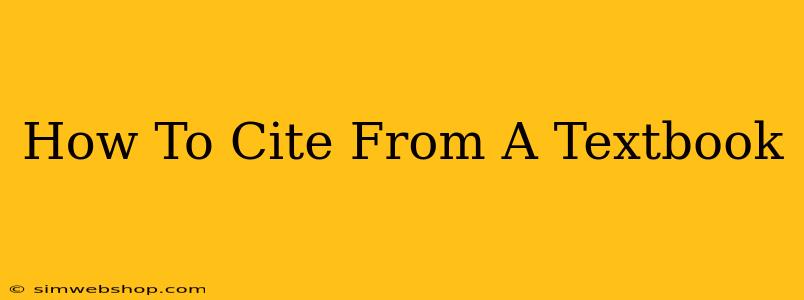Citing sources correctly is crucial for academic integrity. Whether you're writing a research paper, essay, or even a simple assignment, knowing how to cite from a textbook is essential. This comprehensive guide will walk you through the process, covering different citation styles and offering helpful tips to avoid plagiarism.
Understanding Citation Styles
Several citation styles exist, each with its own specific formatting rules. The most common include:
- MLA (Modern Language Association): Commonly used in the humanities.
- APA (American Psychological Association): Predominantly used in social sciences and psychology.
- Chicago/Turabian: Often used in history and other disciplines.
Your instructor will specify which style to use. Always double-check your assignment guidelines! Using the wrong style can significantly impact your grade.
Key Information Needed for Textbook Citations
Before you begin citing, gather the necessary information from your textbook's title page and copyright page. This typically includes:
- Author(s) Last Name, First Name. (If multiple authors, list them in the order they appear on the title page.)
- Book Title: (Italicized)
- Edition: (If not the first edition)
- Publisher:
- Publication Date: (Year)
- Page Number(s): (For direct quotes and specific information)
Example Citations:
Let's look at examples using MLA, APA, and Chicago styles for a hypothetical textbook:
Hypothetical Textbook Information:
- Author: Jane Doe and John Smith
- Book Title: Introduction to Psychology
- Edition: 3rd
- Publisher: Example Publishers
- Publication Date: 2023
- Page Number: 150
MLA Citation:
In-text citation: (Doe and Smith 150)
Works Cited entry:
Doe, Jane, and John Smith. Introduction to Psychology, 3rd ed., Example Publishers, 2023.
APA Citation:
In-text citation: (Doe & Smith, 2023, p. 150)
References entry:
Doe, J., & Smith, J. (2023). Introduction to Psychology (3rd ed.). Example Publishers.
Chicago/Turabian Citation (Notes and Bibliography Style):
Footnote/Endnote:
- Jane Doe and John Smith, Introduction to Psychology, 3rd ed. (Example Publishers, 2023), 150.
Bibliography entry:
Doe, Jane, and John Smith. Introduction to Psychology. 3rd ed. Example Publishers, 2023.
Tips for Accurate Textbook Citations:
- Double-check your information: Ensure accuracy to avoid errors.
- Use a citation management tool: Tools like Zotero or Mendeley can simplify the process.
- Consult a style guide: Refer to the official style guide for your chosen citation style for detailed instructions.
- Consistency is key: Maintain consistent formatting throughout your work.
- Cite everything: Don't forget to cite paraphrased information as well as direct quotes.
Avoiding Plagiarism: The Importance of Proper Citation
Plagiarism is a serious academic offense. Properly citing your sources demonstrates your understanding of academic integrity and avoids accusations of plagiarism. By following the guidelines outlined above and using a consistent citation style, you can ensure your work is both credible and ethically sound. Always remember, when in doubt, cite it out!
Frequently Asked Questions (FAQs)
Q: What if my textbook has multiple authors? List them all in the order they appear on the title page, following the specific format of your chosen citation style.
Q: How do I cite a specific chapter in a textbook? Most citation styles will require you to include the chapter title and page numbers within the citation. Consult your style guide for specific formatting instructions.
Q: What if I can't find a piece of information on the title page? Search the copyright page for publishing information. If necessary, contact your library or professor for assistance.
By following these steps and utilizing the provided examples, you can confidently and accurately cite your textbooks in your academic work. Remember, accurate citation is essential for academic integrity and successful research.

